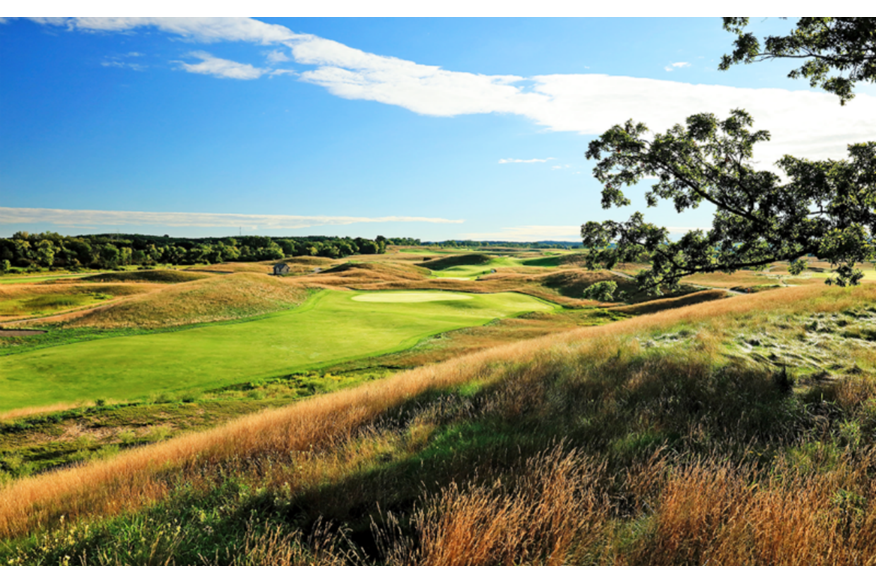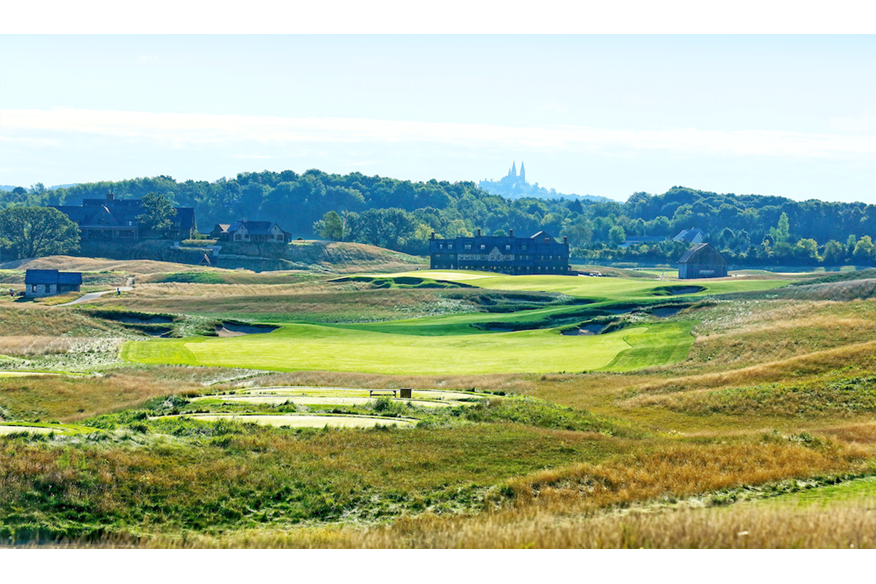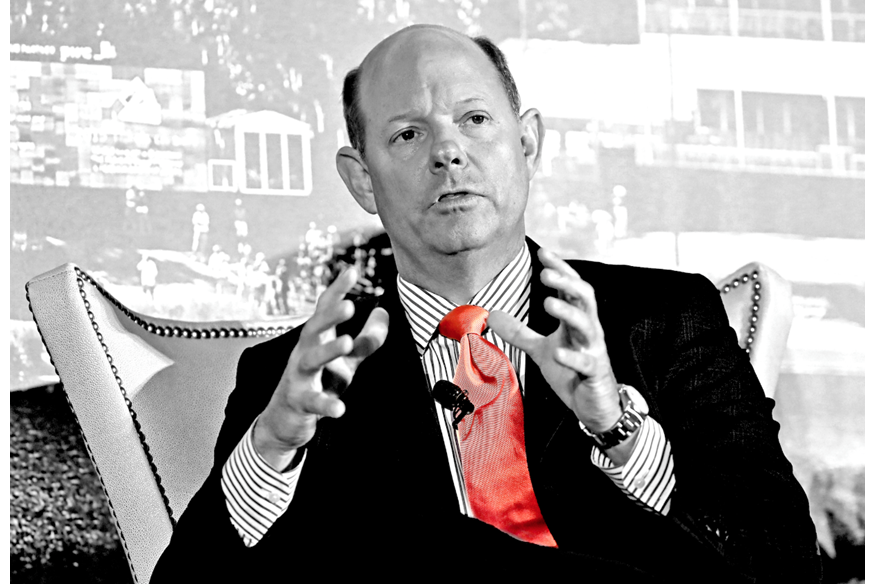US OPEN 2017: Mike Davis on the risk of Erin Hills
Last updated:
Two years on from the calamity of Chambers Bay, Jock Howard sat down with the USGA’s Executive Director and CEO Mike Davis to discuss the merits of Erin Hills and the risks of taking the championship to another untried and untested layout.
Not so long ago, the second major of the year was a one-dimensional, boring, slug-fest; disliked by players and crowds alike. In recent years however, USGA CEO Mike Davis has almost single-handedly reinvented the US Open.
The engaging, enthusiastic and hugely intelligent Davis has brought in concepts like “graded rough” and “architectural integrity “, which are now becoming commonplace concepts, borrowed by other major championships.
By his own admission, he’s got a few things wrong, too – most notably at Chambers Bay in 2015 – and his sanity has been questioned on more than a few occasions. But, he regards these as “battles” and they are certainly not going to stop him experimenting, and ultimately winning the war.
After the problems you encountered at Chambers Bay in 2015, the scorched earth, the unplayable greens, the compromised spectator ‘experience’, how big a risk is Erin Hills?
If we’re being honest, I think we’d probably have liked to spread those two new sites out a bit. It might have been preferable, in an ideal world, not to have two new courses in three years. But, when we looked at those two sites, we saw two new, dynamic markets, which we hadn’t been to before. Both of them are public golf courses and both have their own story. If we could have had several years in a row of tried and tested historic courses, in between the two new ones, we would have done that.
Your point is well made. There are certain parts of this championship which we just do not know what to expect. When we go to a Shinnecock or an Oakmont or a Pebble Beach, we know what those courses are like if it’s windy, if it’s wet. You kind of know what the variables are. And that’s for inside and outside the ropes. So, in some ways we’re going to learn as we go along; whether it’s parking and traffic, or how the golf course plays.
Is that a risk you’re happy to take again?
Well, we wouldn’t be going there if we weren’t. We take the US Open to some older, historical, traditional venues. And as we move it around the US, the thing we always focus on first is the quality of the golf course. Most of them are ‘Top 50’ courses, and although that’s obviously very subjective, we ask questions like ‘Is it good enough to test the world’s best?’ Does it have the infrastructure to put on a US Open? There are questions that will only be answered once the tournament begins, but we’re con dent Erin Hills answers yes to all the questions we asked.

When was the moment you noted Erin Hills as a potential US Open course?
Probably before the 2011 US Amateur. A lot of us had visited the club, walked and played the course and everyone came back very impressed. It’s been on our radar since literally before it was even a golf course. And, most of that was just because we loved the piece of property and were intrigued by it.
Unusually for Wisconsin [which tends to be at, heavy farmland] this is actually the remnants of a glacier which pushed up loads of sand and soil, about 10,000 years ago. There’s wonderful movement to the land. It’s really well-drained. And when you play on well-drained, bouncy land it adds to the test of golf and the enjoyment because you have to think about what happens when your ball lands, and then where it is going to roll to.
We’ve never before taken a US Open to Wisconsin. We tend to concentrate on east coast and west coast courses. So this was a middle America property, a new property with new architecture, plus it’s a public access course, not a private club, so golfers can actually play here. And that’s important to us.
I’ve heard that it was designed specifically to host a US Open. Is that true?
I think that would be inaccurate. When the previous owner – Bob Lang – started it, he knew what a special piece of property he had. And the architects Mike Hurdzan, Dana Fry and Ron Whitten also knew what a great piece of property it was; so they went into it with a very minimalistic mind-set.
We saw the course before it was even built but we didn’t get involved in the design. The only thing we did was point out to them that if they wanted to have a really big event then they needed to think a bit about how you want to move people around, about the road infrastructure and so on. The owner may have said “I want to host the US Open”, and that was actually one of the reasons I went out there the first time. Ron Whitten actually reached out to me in about 2002 and said “There’s this place where they’re going to build a golf course, and it’ll be good enough to host a US Open one day”.
I get those type of communications all the time, and usually they come to nothing. But Ron was learned enough, and knew enough about golf course architecture that we went out and visited it. And now, 15 years later, it actually came true.
How much input has the USGA had in the course this year?
We’ve had some. While we didn’t really have much say in the initial design, we played the US Women’s Public Links there in 2008 and the US Amateur in 2011. Those events showed us that some things didn’t work as well as they could have. When we go to an old course like Shinnecock or Oakmont, they have evolved over 100 years. And they’ve continually made changes, sometimes for championships, sometimes not.
I think what’s happened with Erin Hills is because it’s had these Championships bestowed on it, it’s reacted a little faster than a normal course. So, we’ve had input. But it would be wrong to say it’s a USGA course. Our input has been pretty minimal.

Chambers Bay was, you said, “radically different architecturally” from previous US Open venues. Is Erin Hills similar? Or is it a safer, more expected test?
I think it’s the latter. The architects really went out of their way to make this as minimalistic as possible. So, they just laid these holes out, right on the ground. And some of the changes which were made were because they were almost a bit too minimalistic. But, for the most part, it’s pleasing because it doesn’t look artificial.
At Chambers Bay, where balls just bounced in unique directions, you really won’t see that at Erin Hills. It’s more of a traditional course. The grasses are ne fescue, the putting greens are bent grass and it has very few trees.
The fairways should have a slight tanned tinge to them, because they are fescue. And, if we’re lucky enough that it’s dry, you’re not going to see a dark green course, like you see at some US Opens.
You said after Chambers Bay, “we did everything we could”. How much of your planning is at the mercy of the seasons and the elements?
We feel that – just because of the type of grasses – we took all the precautions we could take this winter. It is really, really cold there – there’s no place in the UK which gets even close to how cold it gets in Wisconsin in the winter – it can be brutal, like Siberia up there! But that said, they did cover all the greens, and apparently they’ve come through the winter beautifully.
But this is a little bit of a different golf course, in that it’s the first time since 1992 that we’ve played on a par 72. And it’s a wider golf course. And the greens aren’t all that undulating. And they’re beautiful bent grass. These things putt almost perfectly. So, I think what’s really interesting is you are going to see lower scoring at this US Open than you typically see.
Is that a good or a bad thing, from the USGA’s perspective?
It’s not bad. At the end of the day, we give the trophy out to the lowest 72-hole score, whether they are +5 or -15. I’ve heard some people say ‘It’s a long golf course’. But this is going to play relatively short, by professional standards, because it is a par 72, so you kind of subtract 400 yards right off the bat there. The other thing is it’s a firm surface, so the ball bounces and rolls. And the fairways, by US Open standards, are definitely generous.
Because it is a bouncy surface, and it does tend to get windy out there, because it’s such an exposed piece of land. Every time I’ve been there, 9 out of 10 days the wind is blowing. I think that is going to be part of the story. And, if it isn’t windy, or if it’s just a light breeze, I’d be shocked if it’s not several strokes under par. And that’s not a negative thing. It is what it is.
You’ve been involved in setting up US Open courses for nearly 30 years, and been in charge since 2006. Would it be fair to say you’ve made it a personal mission to transform the image of the US Open, by taking it to a wider variety of courses, by looking at areas like entertainment and birdies and so on?
I hate to ever use the word “I” because there is a team involved here, but one of the things we did way back in about 2005 was look at everything we were doing. Some people love US Opens. Some don’t. But it’s sort of been the ultimate test. It’s going to test shot-making skills, course management, your nerves, your patience, maybe a little bit more than other weeks.
One of the other things we looked at is do we always have to play the hole the same way every day? Or can we mix it up a little bit? And when you ask yourselves that, sometimes it turns out that the architect wants you to play it those different ways and you have more options.
 The R&A have just under a dozen courses on their Open ‘rota’. How many do the USGA have on their ‘rota’?
The R&A have just under a dozen courses on their Open ‘rota’. How many do the USGA have on their ‘rota’?
I’ll be honest, sometimes we’re envious of the R&A because with a smaller number it’s easier to know those courses. It’s easier to put some infrastructure long-term into those. The players get to know them more. We go to more golf courses, so neither we nor the players know the courses as well.
On the flip side, our country is so big and has so many golf courses, we can have so much variation and we can be radically different from one year to another. That is both a challenge and a blessing.
Is there a cap on how many courses you can consider, or could you just keep expanding to new courses, if they were good enough?
We really do not have a specific rota. But I will say this. There are some great golf courses which I cannot imagine we wouldn’t want to go back to – Pebble Beach, Pinehurst, Shinnecock, Oakmont, Winged Foot… because over time they’ve proved to be such good tests of golf.
Others are retired because they simply couldn’t host a US Open – places like Myopia Country Club, north of Boston, 120 years ago it was a great venue but it doesn’t have the space to hold one anymore. So, some drop out but new ones come along, and that won’t change.
If you want to read more from our sister publication Golf World, subscribe to their magazine

